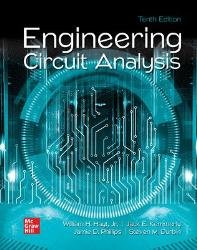Engineering Circuit Analysis, 10th Edition
- Добавил: literator
- Дата: 26-04-2024, 02:06
- Комментариев: 0
 Название: Engineering Circuit Analysis, 10th Edition
Название: Engineering Circuit Analysis, 10th EditionАвтор: William H. Hayt, Jr., Jack E. Kemmerly, Jamie D. Phillips
Издательство: McGraw Hill
Год: 2024
Страниц: 925
Язык: английский
Формат: pdf (true), epub (true)
Размер: 33.8 MB, 85.1 MB
The target audience colors everything about a book, being a major factor in decisions big and small, particularly both the pace and the overall writing style. Consequently, it is important to note that the authors have made the conscious decision to write this book to the student, and not to the instructor. Our underlying philosophy is that reading the book should be enjoyable, despite the level of technical detail that it must incorporate. When we look back to the very first edition of Engineering Circuit Analysis, it’s clear that it was developed specifically to be more of a conversation than a dry, dull discourse on a prescribed set of fundamental topics. To keep it conversational, we’ve had to work hard at updating the book so that it continues to speak to the increasingly diverse group of students using it all over the world.
Although in many engineering programs the introductory circuits course is preceded or accompanied by an introductory physics course in which electricity and magnetism are introduced (typically from a fields perspective), this is not required to use this book. After finishing the course, many students find themselves truly amazed that such a broad set of analytical tools have been derived from only three simple scientific laws—Ohm’s law and Kirchhoff’s voltage and current laws. The first six chapters assume only a familiarity with algebra and simultaneous equations; subsequent chapters assume a first course in calculus (derivatives and integrals) is being taken in tandem. Beyond that, we have tried to incorporate sufficient details to allow the book to be read on its own.
Circuit analysis has long been a traditional introduction to the art of problem solving from an engineering perspective, even for those whose interests lie outside electrical engineering. There are many reasons for this, but one of the best is that in today’s world it’s extremely unlikely for any engineer to encounter a system that does not in some way include electrical circuitry. As circuits shrink and require less power, and power sources become smaller and cheaper, embedded circuits are seemingly everywhere. Since most engineering situations require a team effort at some stage, a working knowledge of circuit analysis therefore helps to provide everyone on a project with the background needed for effective communication.
Consequently, this book is not just about “circuit analysis” from an engineering perspective it is also about developing basic problem-solving skills as they apply to situations an engineer is likely to encounter. Along the way, we also find that we’re developing an intuitive understanding at a general level, and often we can understand a complex system by its analogy to an electrical circuit. Before launching into all this, however, we should begin with a quick preview of the topics found in the remainder of the book, pausing briefly to ponder the difference between analysis and design, and the evolving role computer tools play in modern engineering.
Скачать Engineering Circuit Analysis, 10th Edition
True PDF:
True ePub:
Внимание
Уважаемый посетитель, Вы зашли на сайт как незарегистрированный пользователь.
Мы рекомендуем Вам зарегистрироваться либо войти на сайт под своим именем.
Уважаемый посетитель, Вы зашли на сайт как незарегистрированный пользователь.
Мы рекомендуем Вам зарегистрироваться либо войти на сайт под своим именем.
Информация
Посетители, находящиеся в группе Гости, не могут оставлять комментарии к данной публикации.
Посетители, находящиеся в группе Гости, не могут оставлять комментарии к данной публикации.
